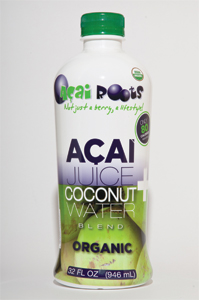Superfruits expand beyond exotic varieties
Nutrient levels highlight more fruits under superfruit umbrella

|
|
Because of its high levels of potassium and magnesium, coconut water could be considered a superfruit, says iTi Tropicals’ Don Giampetro. |
Better-for-you beverages continue to appeal to consumers, and beverage companies continue to find ways to address that trend. According to Chicago-based Mintel Group Ltd.’s “Juice and Juice Drinks” report, 5 percent of launches from January to June 2011 contained antioxidants, which represents a 1 percent increase from the previous period. The report adds that many launches sourced their antioxidant content from superfruits such as acai berries, blueberries, cranberries and pomegranates.
According to the January 2011 Mintel report, 36 percent of American consumers who have bought 100 percent fruit juices look for products with antioxidants.
“Antioxidants are high among the attributes consumers are looking for in superfruits,” says Tom Payne, industry specialist with the U.S. Highbush Blueberry Council, Folsom, Calif.
Payne adds that although the name superfruit is not a regulatory term, it is used to describe fruits that are rich in nutrients, including, for example, antioxidants. Mark Blumenthal, founder and executive director of the Austin, Texas-based American Botanical Council and editor of HerbalGram, agrees that superfruit is not a legal or regulatory term, but says that fruits marketed as superfruits often are associated with antioxidants.
“Antioxidant benefits are obviously one of the key benefits associated with many so-called superfruit items,” he says. “Such activity can often translate into cardiovascular benefits: less cholesterol build-up in arteries reducing arterial plaque formation, thereby reducing risk of hypertension, high blood pressure, stroke, etc.”
Blumenthal adds that antioxidant activity also can translate into reducing risk for some kinds of cancers.
What’s old is new
Commonly associated with nutrient richness and antioxidant quality, superfruits also can be associated with novel tastes, but that is starting to change, experts note.
“Some folks consider only the new, unique, cutting edge and different fruits as superfruits, when in reality there are many tried and true products that have always been superfruits,” says Don Giampetro, vice president of iTi Tropicals, Lawrenceville, N.J. “Some fruits include bananas, prunes, grapes, etc. Even new items like coconut water could be considered a superfruit.
“The coconut itself has been around for a long, long time, but only recently has coconut water emerged,” he continues. “With the high levels of potassium and magnesium it has, it can be considered a superfruit.”
Giampetro adds that the newness of fruit doesn’t matter; it’s the research that is being presented and the level of benefit that can be demonstrated from the fruit that matters, he says.
American Botanical Council’s Blumenthal adds that many fruits that can be found in the common household have benefits that should be recognized.
“Many common, ordinary fruits are ‘super’ when compared to some of those fruits being promoted as such today,” he says. “These might include apples, avocados, bananas, blueberries, cherries, mangos, papayas, all of which have nutritional value and/or biological characteristics that warrant their consumption and possible addition to beverages and so-called functional foods.”
Local focus
Addressing a trend toward U.S. native superfruits, the Highbush Blueberry Council’s Payne says that the popularity and acceptance of blueberry is on the rise. “Blueberries are growing in popularity and it’s no wonder that they are becoming one of the hottest ingredients in all beverages lately,” he says. “Part of the reason is health, but part is also the amazing, across-the-board appeal of blueberries. Consumers not only equate blueberries with antioxidants, they trust blueberries as a known and desirable quality.”
He adds that blueberries have an all-American association, and being a native American fruit also can project a responsible carbon footprint by product developers.
Another well-known fruit that could have a future under the superfruit umbrella are cherries, specifically sour cherry.
“One we see that’s going to come out on a larger scale is sour cherry,” says Chris Schubert, vice president of sales for Encore Fruit Marketing, Bellingham, Wash. “Sour cherry’s been around obviously for a long, long time, but I don’t think [it] has really been perceived as a superfruit, but it certainly falls within that category due to its nutraceutical benefits. But again, the consumer out there looks at sour cherry just as a regular fruit flavor but not necessarily as a superfruit.
“Once the consumer, I think, is made aware of some of the nutritional properties of sour cherry, they will look at other beverages made with sour cherry and we can [hope] that sour cherry will become more popular,” he continues.
Whether it is fruits native to the United States or more exotic fruits, knowledge and marketing efforts will continue to play a role in the future of superfruits.
“I think [superfruit] awareness comes from the knowledge of the consumer about these fruits,” Schubert says. “They read about it in the media and the Internet is full of information about superfruits. I think overall consumer desire for improved nutrition and wanting to have more variety in blends, that’s probably the biggest reason [for increased awareness], and the marketers and producers have realized that and are aware of this phenomenon and they’re out there looking for new ingredients to satisfy that demand.”
Exotic appeal
Although native U.S. superfruits are finding their place in the beverage market, exotic varietals are still garnering attention. “Acai, goji, mangosteen, guava and mango are some of the superfruits, which are extremely popular,” iTi’s Giampetro says. “But recently, lesser known superfruits like camu camu, dragon fruit, acerola, baobab, etc., are also becoming popular.”
When it comes to popularity and stability, Encore Fruit Marketing’s Schubert says that pomegranate has shown to have stability in usage, but others, such as acai, have started to decline. “Pomegranate, which is right there at the top of the superfruit category, is really very stable and has established itself very well [and] almost become a mainstream flavor,” he says.
But establishing stability in the superfruit market is not an easy task to achieve.
“[Superfruits] go through cycles, lifecycles, like most other fruit beverages,” Schubert says. “Typically their lifecycles are a little bit shorter than beverages made from traditional fruits. Part of that is the consumer is curious about new fruits but unless they really like it, it’s a flavor that they’re really comfortable with and really enjoy, they may not buy it for an extended period of time, so the interest in that particular fruit may level off a little bit.”
Even though superfruits might go through lifecycles of popularity, the attention garnered from their health benefits still gives them positive appeal. iTi’s Giampetro says fruits such as acerola or camu camu are considered superfruits because of their exceptionally high vitamin C levels, which can appeal to consumers.
“Consumers may drink a fruit-based beverage just for the experience of trying a particular fruit flavor,” he says. “However, now in today’s market, the consumer is consuming that product to fulfill their daily requirements on calories, fats, [carbohydrates], nutrients, etc. They want to consume items that are good for them. If they know that a serving of juice gives them a certain percent of their daily requirement of calcium or vitamin C or some other nutrient, they are more apt to consume this on a regular basis.
“The beverage-maker/formulator wants to continue producing [and] marketing products that will achieve this and keep the consumer interested and there is the continued market for finding new and unique superfruits,” he continues.
Emerging fruits
Although Giampetro isn’t sure what will be the next big superfruit to emerge for the beverage industry, he has noticed maqui berry gaining more popularity, but others could also include borojo out of Colombia, amla out of India, or prickly pear, which has been around for awhile but has not picked up steam, he says.
Encore Fruit Marketing’s Schubert also sees an opportunity for seabuckthorn because of its high versatility and high number of phytochemicals, which make it attractive for the beverage industry, he says.
“Some of the other superfruits can become very expensive and seabuckthorn, fortunately, is not very expensive, so we see that emerging and becoming the next big item in the beverage industry,” Schubert says.
Some beverage companies also are starting to employ the use of coffee fruit. For instance, KonaRed, Kalaheo, Hawaii, produces its product of the same name, which includes ripe fruit from the coffee plant. The company says the coffee fruit in the juice contains antioxidants that are absorbed directly at the cellular level. Earlier this year, the company released KonaRed Coconut Water, which is made from the fruit of the coffee plant, but also includes coconut water.
Princeton, N.J.-based Bai Brands also offers a product line of beverages infused with coffee fruit. Ben Weiss, president and chief executive officer of Bai Brands, told Beverage Industry in its October 2011 issue that the products are packed with antioxidants and contain 4,000 oxygen radical absorbance capacity (ORAC) units, based on testing from Brunswick Labs.
Because some of the non-native superfruits to the United States are not as readily available in fresh form, beverages lend themselves to allowing consumers to try new superfruits.
“Juices and fruit blend beverages are popular for consuming superfruits at present as beverages seem preferred for convenience and product enjoyment,” Giampetro says. “Fruit juice remains one of the only foods consumers still regard as ‘natural’ even when pasteurized and processed.
“The delivery of the benefits of a superfruit is very easily done through a beverage,” he continues. “Whether its antioxidants, phytonutrients, other key vitamins or minerals that are found in the particular superfruit, putting the fruit into a beverage is rather simple and straightforward.”
Using superfruits in beverages also can address the lack of supplies and the deficit of emerging superfruit varieties compared to the last 10 years, Schubert says.
“The [superfruit] supplies are limited and it’s just not being brought to the forefront like it used to over the last 10 years,” he says. “Having said that, beverages are still probably the easiest way for a consumer to take in some of these superfruits that easily process into juices and purees and therefore be incorporated into beverages.
“It’s a convenience factor too; it’s easy to drink a beverage and consume the superfruits that way rather than trying to cook them or consume them as a snack,” he continues. “I think that the beverage industry will always be on the forefront of the superfruit category and will find ways to incorporate them into their products.” BI
Looking for a reprint of this article?
From high-res PDFs to custom plaques, order your copy today!





